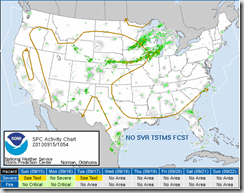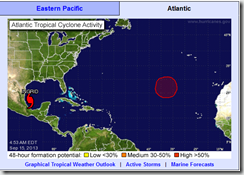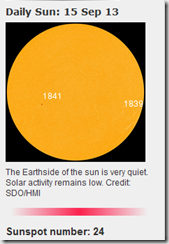Photo Credit- NOAA Know your Risk
Note: This is day 15 of National Preparedness Month. Follow this year’s campaign on Twitter by searching for the #NPM or #NPM13 hash tag.
This month, as part of NPM13, I’ll be rerunning some updated preparedness essays (like this one) , along with some new ones.
# 7774
Every day busy CEOs along with investors, emergency planners, politicians- and even the President of the United States - receive specialized Daily Intelligence briefings outlining current or anticipated threats, along with other vital information.
While you may not hold the fate of nations, a billion dollar portfolio, or a fortune 500 company in your hands you do have a need to know your risks if you want you and your family to be prepared for a disaster.
And those risks can, and do, change on a daily basis. Particularly those involving climate and weather.
Fortunately, the Internet makes it easy to create a short list of websites to visit each day (I do so early each morning) that in a few short minutes will give you an early warning of what threats might be expected in the next few days.
Depending where you live, and where your personal interests lie, you will probably want to customize your `daily briefing’. But to get you started, a quick tour of mine.
Note: I quickly scan these websites for news, alerts, or forecasts of interest for my region. I certainly don’t attempt to read them in depth each day.
First stop, NOAAWatch’s Daily Briefing which provides an excellent overview of the natural threats facing the nation.
More than just weather, this NOAA page also tracks other natural threats such as earthquakes, volcanoes, and wildfires.
My second stop is usually NOAA’s Storm Prediction Center, which looks ahead as far as a week for areas that may expect severe weather. At a glance I can see when, and where, weather trouble is expected. This is particularly important during the spring and summer tornado season.
And during hurricane season, I also swing by the National Hurricane Center website each morning (and if there is an active storm, several times each day).
Although the sun remains unusually quiet, scientists believe we should hit the Solar Maximum over the next few months , so I also swing by Spaceweather.com or NOAA’s SPACE WEATHER PREDICTION CENTER for the latest on solar activity.
And last, but not least, I visit the FEMA Blog to see what they are keeping an eye on.
During the day and overnight, I rely on NOAA WEATHER RADIO (NWR) and Twitter to follow @FEMA, @NHC_Atlantic, @NOAA and @CraigAtFEMA for real-time emergency alerts.
Like having an emergency kit and a first aid kit - having a weather radio is an important part of being prepared.
Of course, just knowing about the threats isn’t enough. You have to make use of that information.
To learn how to prepare as an individual, family, business owner, or community I would invite you to visit the following sites and use THIS LINK to access some of my recent preparedness blogs.
FEMA http://www.fema.gov/index.shtm
READY.GOV http://www.ready.gov/
AMERICAN RED CROSS http://www.redcross.org/
While some people lie awake at night worrying about disasters, I’ve discovered that being prepared is the key to sleeping well.
Preparing is easy.
It’s worrying that’s hard.







